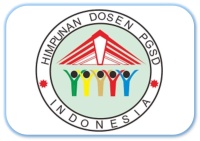Penerapan Model Kooperatif Tipe Jigsaw Untuk Meningkatkan Hasil Belajar Matematika Kelas IV SD
Abstract
This study aims to describe the application of the Jigsaw Cooperative model to improve mathematics learning outcomes in circumference and area of plane figure in fourth grade of Elementary School. The type of this research is Classroom Action Research (CAR) using qualitative and quantitative approaches. The research subjects were teachers and 30 students in the fourth grade of elementary school 15 Koto Lalang. The results of this study showed an improvement the outcomes of mathematics learning. The result of the lesson plan in the first cycle was 82.14% to 94.36% in the second cycle. The result of observation for teacher and student aspects in the first cycle was 77.78% to 90.28% in the second cycle. The assessment of mathematical learning outcomes of students in the first cycle was about 71.51 to 83.07 in the second cycle.
Keywords
References
Ahmad, Syafri. 2016. Penggunaan Model Pembelajaran Jigsaw Untuk Meningkatkan Hasil Belajar Sifat-Sifat Bangun Datar Di Sekolah Dasar. Pedagogi, Volume 16, No.1 April 2016
Hijrihani & Wutsqa. 2015. Keefektifan Cooperative Learning Tipe Jigsaw dan STAD ditinjau dari Prestasi Belajar dan Kepercayaan Diri Siswa. PYTHAGORAS: Jurnal Pendidikan Matematika, Volume 10-Nomor 1, Juni 2015, (1-14).
Istihapsari. 2017. Meningkatkan Pemahaman Konsep Materi Matematika SMP Menggunakan Model Pembelajaran Kooperatif Tipe Jigsaw Pada Mahasiswa Prodi Pendidikan Matematika UAD. AdMathedu, Vol 7, Juni 2017 ISSN: 2088-687X.
Karacop, A. 2017. The effects of using Jigsaw Method based on cooperative learning model in the undergraduate laboratory practices. Universal Journal of Educational Research, 5(3): 420-434.
Kordaki, M., & Siempos, H. 2010.The Jigsaw Collaborative Method within Online Computer Classroom.Proceeding of the 2nd International Conference on Computer Supported Education.
Kunandar.(2010). Langkah Mudah Penelitian Tindakan Kelas sebagai Pengembangan Profesi Guru.Jakarta :Raja Wali Press
Lenny Zaroha; Firman; Desyandri. (2018). The Effect of Using Quantum Teaching and Motivation in Learning Toward Students Achievement. JAIPTEKIN | Jurnal Aplikasi IPTEK Indonesia, 2(4), 14–20. https://doi.org/https://doi.org/10.24036/4.32143
Miaz, Y., Helsa, Y., Desyandri, & Febrianto, R. (2018). Cartography in designing digital map using Adobe Flash CS6. Journal of Physics: Conference Series, 1088. https://doi.org/10.1088/1742-6596/1088/1/012069
Nurulaen, Y. (2011). Edisi Khusus No. 2, Agustus 2011.Jurnal Penelitian Pendidikan, Edisi Khus(2), 154–163.
Uno, Hamzah B, dkk. 2012. Menjadi Peneliti PTK yang Profesional. Jakarta: Bumi Aksara.
Permendikbud.2016. Peraturan Menteri Pendidikan dan Kebudayaan Republik Indonesia.Jakarta: Kementerian Pendidikan dan Kebudayaan.
Rusman. 2011. Model-Model Pembelajaran Mengembangkn Profesionalisme Guru. Jakarta: PT Raja Grafindo Persada.
Sumarni.2016. Upaya Meningkatkan Kemampuan Berhitung Melalui Penerapan Model Pembelajaran Numbered Heads Together dengan Pemanfaatan Alat Peraga Sederhana Materi Pembagian Siswa Kelas II.Jurnal Refleksi Edukatika, 7(1), 62
Susanto, Ahmad. (2013). Teori Belajar dan Pembelajaran di Sekolah Dasar. Jakarta: Kencana Prenada Media Group
DOI: http://dx.doi.org/10.24036/e-jipsd.v7i6.6655


